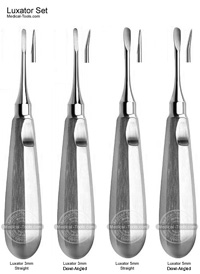A Dental instrument used to extract teeth. This specially designed periodontal ligament knife has a fine tapered blade that compresses the alveolar, cuts the membrane, and eases the tooth from its socket. The ability to reduce trauma during tooth extraction is becoming increasingly important, especially for patients requiring subsequent implant placement with minimal bone loss. Medical Tools dental Luxators are specially designed periodontal ligament knives with a fine tapered blade that compresses the alveolar, cuts the membrane, and gently eases the tooth from its socket reducing damage to surrounding tissue and keeping a better anatomy for an implant site.
The Luxator Instruments are used by cutting and rocking instead of the traditional elevating methods of lifting and prying. The rigid thin blade of the Luxator is inserted into the periodontium two-thirds the length of the root, allowing the final loosening and removal of the tooth to be performed with minimal amount of force. The result is a clean extraction with little tissue damage and less postoperative bleeding and pain.
Qualities of Luxators
Medical Tools Luxators are used by professionals because
- Extremely Flat, Delicate and Sharp Instruments Cut Periodontal Ligament while Preserving Bone Anatomy
- Thin, Down Angled, Tapered Tips ensure smooth widening of the Alveole
- Fine Blade Inserts between Bone and Root with minimal damage to Bone Structure
- Alternative to standard elevators for less Traumatic Extractions
- Set Includes both Straight and Down Angled Tips for access to both Anterior and Posterior teeth
Luxators Sizes
Most commonly used sizes are
- 3mm Straight
- 3mm Down Angled
- 5mm Straight
- 5mm Down Angled
Precautions to be taken while using Luxator
- The compact bone is thickest on the buccal side of the first and second molars in the maxilla and should be luxated from the palatal side.
- The compact bone is thickest on the buccal side of the second and third molars in the mandible and should be luxated from the lingual side.
- To minimize the risk of alveolar ridge fractures, the 5mm Luxator should be used buccally & lingually in molar region.
- The maxillary lateral incisor should be luxated in a palatal direction because of the angle of the root.
- Since most roots are normally curved distally, this should be taken into consideration during extractions.



